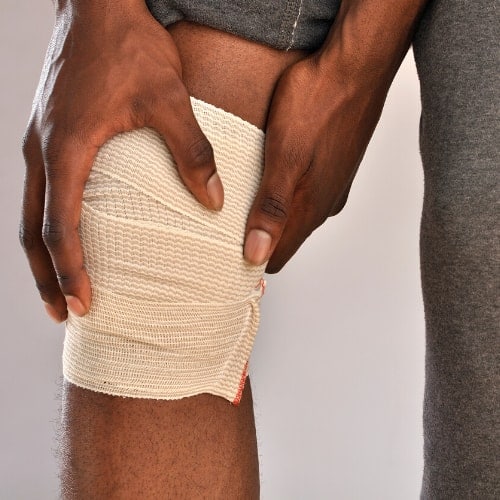Is Quality of Life Really Elective?
We Don’t Think So
The Most Experienced, Comprehensive Joint Replacement Team In WNY
Is Knee or Hip Replacement Right for you?

Your Joint Replacement Questions Answered
If you’re suffering from pain and loss of function in your hips or knees, we have the resources you need to learn more about symptoms, non-surgical treatments, joint surgery options, total joint replacement, and recovery. People often put off joint replacement surgery for many reasons. Not wanting to live life to the fullest, isn’t one of them.
Our Frequently Asked Questions have all of your answers and information you need to know when deciding if joint replacement surgery is for you.
Want some alternatives to surgery? Download the guide.
Your Pain Doesn’t Wait Until You Decide

As hip and knee arthritis worsens, the stiffness of the arthritic joints also worsens. We know that you want to get back to the life you love. We also know that you have a lot of questions about joint replacement surgery.
Nearly every knee and hip surgery we do, the patient says they wish they had done it sooner. They can enjoy activities they had left behind, they can do their daily tasks and sleep without pain. They can go about their day not worrying about how and when to manage their pain for any upcoming outing or vacation they may have planned.
Meet The Surgeons


Mark Mieth, M.D.

Joseph A. Bax, M.D.

Timothy McGrath, M.D.

Our Partners At UBMD Orthopaedics & Sports Medicine

William M. Wind, M.D.

Matthew DiPaola, M.D.

Jesse G. Fodero III, MD
Primary Care Sports Medicine, UB Concussion Management Clinic
A center of excellence
Keeping Care Local.
Request An Appointment
Frequently Asked Questions
Full vs Partial Knee Replacement
Partial Knee Replacement
Partial Knee Replacement
Total Knee Replacement
This procedure has been revolutionary to orthopaedics giving many patients the ability to return to function and enjoy their lives with implants lasting about 10-15-years. While the surgery and recovery are longer, the lifetime of the implants is much greater than in partial knee replacements.
Important For Both
Both partial and total knee replacements can be highly successfully for patients who are good candidates. It is important to discuss the risks and benefits of each type of surgery with your surgeon so that your expectations
are in line with the procedure you elect to have.
Remember that both of these procedures are replacements, and you should follow the activity restrictions your surgeon provides you.
Neither procedure is designed to hold up to the rigors of high-impact sports.
Total Hip Replacement
The first step when making the decision about hip replacement is to meet with your surgeon to see if you are a candidate for total hip replacement surgery. Even if the pain is significant, and the X-rays show advanced arthritis of the joint, the first line of treatment is nearly always non-operative. This includes weight loss if appropriate, an exercise regimen, medication, injections, or bracing. If the symptoms persist despite these measures, and with corroborating X-rays, then you may consider surgery.
How Long Will the New Joint Last?
Most current data suggest that both hip and knee replacements have an annual failure rate between 0.5-1.0%. This means that if you have your total joint replaced today, you have a 90-95% chance that your joint will last 10 years, and an 80-85% that it will last 20 years. With improvements in technology, these numbers may improve.
Despite such improvements it is important to maintain long-term follow-up with your surgeon to assure your replacement is functioning appropriately.
How Long Will the New Joint Last?
Most current data suggest that both hip and knee replacements have an annual failure rate between 0.5-1.0%. This means that if you have your total joint replaced today, you have a 90-95% chance that your joint will last 10 years, and an 80-85% that it will last 20 years. With improvements in technology, these numbers may improve.
Despite such improvements it is important to maintain long-term follow-up with your surgeon to assure your replacement is functioning appropriately.
Are All Hip Replacement Implants the Same?
The ball can be composed of either metal (cobalt chromium alloy) or ceramic, and the liner can be made of plastic (polyethylene), metal, or ceramic. The ball and liner can then be used in different combinations and are named for the respective ball liner combination (metal on poly, ceramic on poly, ceramic on ceramic, etc.).
In 2015, the vast majority of bearings utilized a polyethylene liner with either a metal or ceramic head, with other combinations being used with less frequency. You can discuss these differences with your surgeon to determine which implant is best for you.
Are Surgery and Recovery Painful?
Early range of motion and rapid rehabilitation protocols are also designed to reduce early stiffness and pain, making the procedure in general much less painful than in years past. You may have relatively mild pain following the procedure, or you may have a more difficult time than others. Everyone is unique and handles and perceives pain differently.
What is Minimally Invasive Surgery?
What is the "Approach?"
The most common approach today is referred to as the “posterior approach,” which is done from the back of the hip. Some more recent improvements to this approach (small incision and less tissue trauma) have been called “mini posterior approach.” Another currently popular approach is known as the “anterior approach,” which is performed from the front of the hip. The lateral approach is less frequently used but a viable approach for the surgery.
How Big Will My Scar Be?
Will I Need General Anesthesia?
can reduce complications and improve your recovery experience with less pain, less nausea, less narcotic medicine required
How Long Will I Stay at the Hospital?
How Long Does it Take to Recover?
How Long Will I Need Physical Therapy?
Total Knee Replacement
The first step when making the decision about knee replacement is to meet with your surgeon to see if you are a candidate for total knee replacement surgery. Even if the pain is significant, and the X-rays show advanced arthritis of the joint, the first line of treatment is nearly always non-operative. This includes weight loss if appropriate, an exercise regimen, medication, injections, or bracing. If the symptoms persist despite these measures, and with corroborating X-rays, then you may consider surgery.
How Long Will It Last?
How Long Does A Knee Replacement Last?
What Types of Implants Will I Get?
The orthopaedic implant industry has developed a number of innovative technologies in an effort to improve the outcomes of total joint replacement surgery.
Here are specific implant design terms:
• Gender-specific: This refers to a modified implant design that accounts for average anatomic differences between men’s and women’s knees. Most manufacturers have incorporated similar modifications in their newer designs, which allow for more sizing options so that the prosthesis can be more accurately fit to the patient’s native anatomy and recreate the natural function of the knee.
• Rotating platform: This refers to a plastic bearing that independently rotates on a metal tray on which it is seated. More often, the plastic bearing locks into the metal tray – referred to as a “fixed bearing.” Some theoretical advantages to the rotating platform concept when it was initially designed was that it could reduce the wear of the plastic bearing, reduce the rate of loosening of the metal parts, and better replicate how a patient’s knee works (kinematics). Most current data shows that after five to ten years in use, there does not appear to be any difference between rotating platform and fixed bearing designs in any of these outcomes.
Will My Surgeon Use a Computer or Robot During Surgery?
Is Knee Surgery and Recovery Painful?
Early range of motion and rapid rehabilitation protocols are also designed to reduce early stiffness and pain, making the procedure in general much less painful than in years past. You may have relatively mild pain following the procedure, or you may have a more difficult time than others. Everyone is unique and handles and perceives pain differently.
Can I Walk After Surgery?
How Long Will I Need Physical Therapy
About Osteoarthritis
Osteoarthritis (OA) is a common disorder that affects the joints and is caused by a loss of cartilage. Cartilage is the covering over the ends of bones that serve to provide a smooth gliding surface. When this cartilage surface is lost or destroyed, the underlying bone becomes exposed, causing pain when the joint moves or immobility.
Do I Have Osteoarthritis?
Do I Have Osteoarthritis?
Causes
• The global rise in obesity correlates with a significant rise in the frequency of arthritis, particularly in the knee joint.
• Genetics clearly plays a role and has been correlated with osteoarthritis especially in the joints of the hand and wrist.
• Trauma and injury can result in damage to the cartilage, and poor alignment of the bones can contribute to the development of osteoarthritis.
• Instability of the joints related to poor ligaments or weakness can also lead to cartilage loss and ultimately osteoarthritis.
• Age has been associated with osteoarthritis. Although the frequency of OA increases with age, it does not occur in all individuals and should not be considered inevitable.
Should I See a Doctor?
osteoarthritis.
Treatment will be based on how far the disease has progressed and how bad and how long your joint has hurt.
It is important to understand that not all hip and knee pain is osteoarthritis, and there are other diagnoses and treatment options depending on the underlying cause of your pain.
Is There a Cure?
Even though there is no cure for the disease, we can treat the symptoms you’re experiencing and provide significant pain relief and improvement in function. It is important to understand the extent of your osteoarthritis and how this relates to your symptoms and treatment options.









